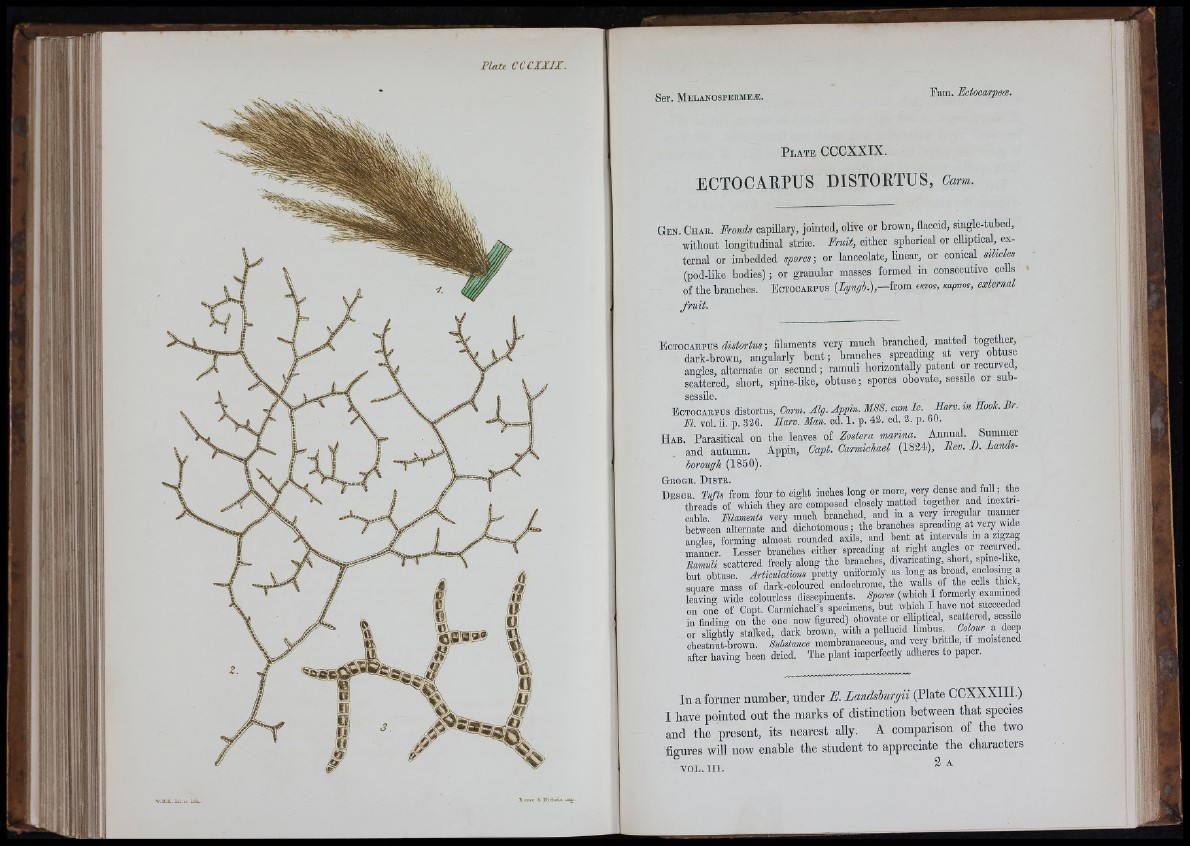
M
■ l
f Í i . ■ ii.
t ' I i
P l a t e CCCXXIX.
ECTOCARPUS DISTORTUS, Carm.
G e n . C h a r . Froncis capiUary, jointed, olive or brown, flaccid, single-tubed,
without longitudinal striæ. F m it, either sphencal or eUiptical, external
or imbedded spores; or lanceolate, linear, or conical sxlicles
(pod-like bodies) ; or granular masses formed in consecutive cells
of the branches. E ctocarpus (Dyjir/A),— from sagnos,
E ctocarpus distortus; fllaments very much branched, matted together,
dark-brown, angularly b en t; branches spreading at very obtuse
angles, alternate or secund ; ramuli lionzonta.Uy patent or recurved,
scattered, short, spine-like, obtuse; spores obovate, sessUe or sub-
scssils«
E c t o c a r p u s distortus. Carm. Alg. Appin. MSS. cum Ic. Harv. in Hook. Br.
m . vol. ii. p. 336. Harv. Man. ed. 1. p. 43. ed. 3. p. 60.
H ab . Parasitical on the leaves of Zostera man»«. Annual. Summer
and autumn. Appin, Capt. Carmichael (1824), Bev. B . Landsborough
(1850).
G e o g r . D i s t e .
D e s o r . Tufts from four to eight inches long or more, very dense and fuU; the
threads of which they are composed closely matted together and inextii-
cable. Mlamnts very much branched, and in a very m-egular mannei
between alternate and dichotomous; the branches spreading at very wide
ansrles forming almost rounded axUs, and bent at intervals in a zigzag
manner Lesser branches either spreading at right angles or recurved.
Bamuli scattered freely along the branches, divaricating short, spme-like
but obtuse. Articulations pretty uniformly as long as broad, bsm a
square mass of dark-coloured endochrome. the walls of the ceJs thick
leaving wide colourless dissepiments. Spores (which I formeily examined
on one of Capt. Carmichael’s specimens, but which I have not succeeded
in finding on the one now figured) obovate or elliptical, scattered, sessüe
or slightly stalked, dark brown, with a pellucid limbus CoZ«r a deep
chestnut-hrown. Substance membranaceous, and very brittle, if moistened
after having been dried. The plant imperfectly adheres to paper.
In a former number, under L. Landsburgii (Plate CCXXXIII.)
I have pointed out the marks of distinction between that species
and the present, its nearest ally. A comparison of the two
figures will now enable the student to appreciate the characters
voL.m. 2 a
t !